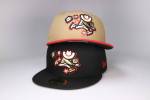Gizzard shad key to striper success
For nearly 32 years, Jim Goff has been a fixture on Lake Mead and Lake Mohave, where he has spent his “retirement” years guiding fishermen in search of striped bass. That makes him not only the self-described old-timer among Southern Nevada’s fishing guides but also a knowledgeable resource when it comes to striper fishing on Southern Nevada’s waters.
At one time, 16 licensed fishing guides were on Mead and Mohave. Now there are nine, according to Goff. He attributes the reduction, at least in part, to the poor economy the past few years. “People don’t spend their money the way they used to,” he said.
In recent months, business has picked up for Goff and the other remaining guides. Nevertheless, he still took time to share a few tips on fall and winter striper fishing along with a few fish stories.
The key to success is gizzard shad. To illustrate that point, Goff shared the story of a client’s recent catch. Goff put a gizzard shad on his client’s hook and began slow trolling with his electric trolling motor.
“Pretty soon he says, ‘I got one!’ I turned around, and that rod is bent double, and (the fish is) heading straight out to the deeper water,” Goff said. “Well, I know it’s a bigger fish, and this is 10-pound line. He’s fighting and fighting and fighting. When we net it, it’s a 12-pound striper.”
Whether you are slow trolling with gizzard shad or simply dropping them over the side, striped bass will hit them, but Goff believes slow trolling is the most effective way to catch stripers. He uses a Carolina rig with a 3-foot leader in front of his sinker. In shallow water, about 30 feet deep or less, he uses a half-ounce sinker and a hook that is large enough to go through the top and bottom lips and still have enough of the hook exposed to ensure a catch.
“If you let your bait back about six or eight boat lengths, that sinker is just bouncing off the bottom,” Goff said. “It’s puffing up little clouds of mud, and then 3 feet right behind it is this gizzard shad that is still alive and fighting. He is kind of controlled by the line and is easy pickings. That is how we have had most of our success with gizzard shad.”
Another approach is to net the larger shad, with some pushing as much as 3 or 4 pounds. Put a treble hook through both lips and place a stinger, or second hook, in the fish’s vent. Then, with no additional weight added, troll with the fish on the surface behind the boat. The stinger will help catch fish when they short-strike the bait.
When I voiced surprise that a striper would take a bait that big, Goff responded by asking, “Did I tell you the one about the hat?”
It seems that on one windy day, he and his clients were drift fishing in the Sand Island Cut when one of his clients lost his hat to a wind gust. The hat, Goff said, was similar in color to that of a 2-pound or larger gizzard shad.
“We turn around. The waves are still a foot high in that cut and 3 feet on the open lake,” Goff said. “We get about 30 feet from this hat, all we see is a flash in the waves, and this hat is gone! One of those big stripers thought he had one of them big gizzard shad up on the surface, and he took that hat. I (kid) you not.
“I tell people that story, and they say, ‘Well, I’m going to get a hat and put some hooks on it.’ ”
One of the things Goff likes about gizzard shad is they have tough mouths and stay on the hook better than threadfin shad, but you also can cut the shad into strips and use them when still fishing or drifting.
The key to netting shad is getting on the water before or just at daylight and working the warm water inflow in the Las Vegas Wash. Focus on the turbid water that makes it tough for the fish to see the net dropping around them.
For information about Goff’s charters, visit www.fishlakemead.net.
Freelance writer Doug Nielsen is a conservation educator for the Nevada Department of Wildlife. His “In the Outdoors” column, published Thursday in the Las Vegas Review-Journal, is not affiliated with or endorsed by the NDOW. Any opinions he states in his column are his own. He can be reached at intheoutdoorslv@gmail.com.






















